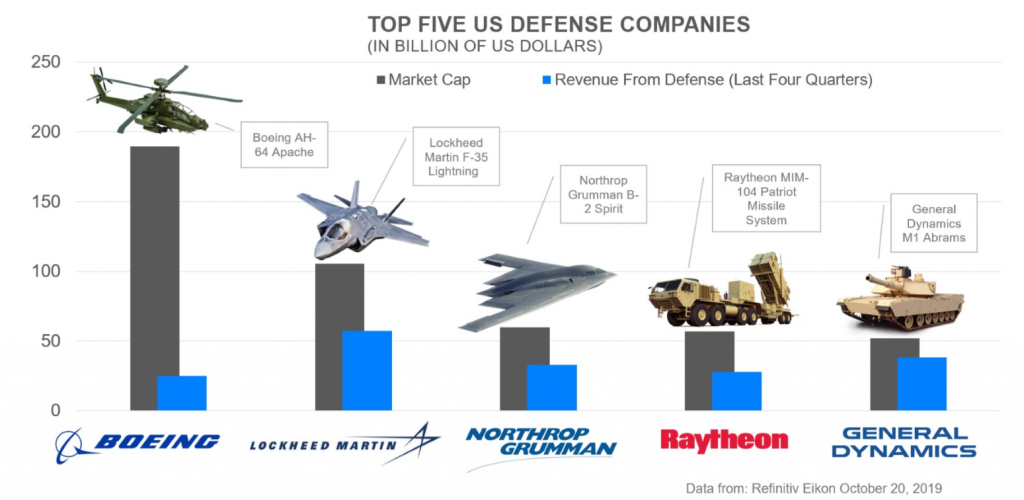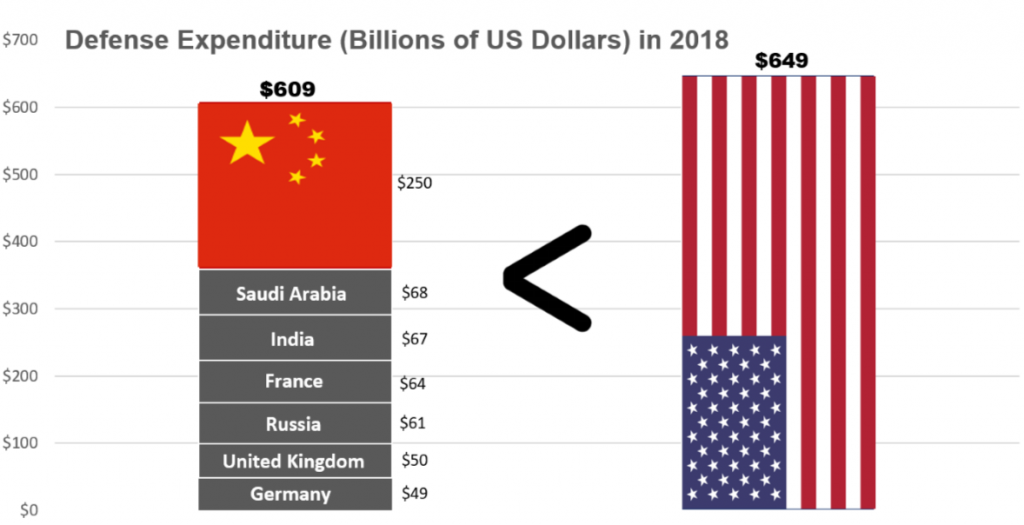US Defense Industry: Global Conflict Lifting Profits
In this issue
- Post Cold War peace dividend came and went
- US debt is a constraint on its military capacity
- America’s military strategy has shifted back towards a “great powers” conflict scenario
- US defense sector is a major contributor to the economy and offers several world class companies to investors
When the Berlin Wall fell nearly 30 years ago, it marked the beginning of the end of the Cold War between the West and Communism. One of the most optimistic predictions that came out of this historical event was that there would be a “peace dividend.” The dividend would come from the belief that with the struggle against Communism over, the huge demands of military spending could be scaled down. In turn, the savings could be channeled back towards social programs and a reduction in the national debt buildup of Western nations. Analysts and even world leaders such as George Bush and Margaret Thatcher gave the concept legitimacy.
What Happened to the Peace Dividend?
The scale back in defense spending was mainly noticeable in Western Europe and in Russia. For the United States, it was a much different experience. American military spending fell rapidly from 1989 to 1993 and then remained flat between 1993 and 1999. But this trend soon came to a halt with the attacks on the US homeland on September 11, 2001. After the Cold War came the War on Terror, the War in Afghanistan and the War in Iraq.
As history has unfolded, the peace dividend was relatively short-lived and the reality of what has taken place over the last 30 years has made the concept of a “peace dividend” nothing short of a fantasy. As a share of global military expenditures, US military spending comprises about half of the world’s total spending. Rather than being a sunset industry, aerospace & defense has become a growth industry.
Many analysts have said, partly in jest, that they would much prefer the certainty of the Cold War over the instability of today. Given the tensions and fears that existed during the Cold War this is a staggering statement but one that is understandable. At least in the “old days” it was one enemy – the Soviet Union – that had to be confronted. Today, the list of challenges range from non-state actors such as ISIS and Al-Qaeda; the rapid rise of China as a military power; countering Iranian influence in the Middle East; maintaining a counterbalance to Russian influence and defending against cyber attacks from both state and non-state actors.
China Pushing US Defense Spending
As much as the current news headlines are focused on the US-China trade dispute, in the background looms the competitive military threat from China. In its annual report on China’s military to the US Congress, the US Defense Department stated that China is focused on making its armed forces into a “world-class” military and becoming the preeminent power in the Indo-Pacific region. In September, Chinese President Xi Jinping stated that “There is no force that can shake the status of this great nation. No force can stop the Chinese people and the Chinese nation forging ahead.”
Flashpoint: South China Sea
The US Defense Department expects China to escalate its initiatives to build bases abroad in foreign nations. The first and perhaps most important example of China projecting its goal of maintaining dominance in the Pacific is the building of bases in the South China Sea. It has undertaken measures to dredge reefs and build bases and artificial islands to project its control of and claim to this vital international shipping route.
Officially, China says that the 3000 acres of constructed islands were aimed at maritime safety and natural disaster support. But China’s neighbors and the US are suspicious given the ports, runways and reinforced bunkers that have sprung up on these man-made islands.
Each month, thousands of ships carrying about a third of the world’s trade, almost half of its natural gas cargos and about 10 million barrels of crude oil pass through this area on its way to China, Japan and South Korea. This underscores the importance of this vital waterway.
While Western military experts have long warned of China’s fast rising military capability, China was able to deliver a surprise in a recent military parade marking the 70th anniversary of communist rule over China. China showed the world how modern its missile systems have become by showing four missile systems that the world has never seen before or even knew were being built.
US Military Worries About the Economy
The defense sector is a significant contributor to the US economy and the companies that make up the sector are truly world class in what they do. According to the Aerospace Industries Association, in 2018, these companies employed over 2.5 million Americans at above-average wages totalling $247 billion and generated a $90 billion trade surplus. For comparison, the chart on page 2 shows the largest US aerospace and defense companies by market value (capitalization) and the amount of revenues they draw from defense spending.

But as vital as these companies are, both the White House and Congress are demanding more scrutiny on where and how the nearly $700 billion budget is being spent. As the chart above shows, US defense spending still exceeds the spending of the next 7 nations combined. In a budget that large, surely there are efficiencies to be found. This is more important than ever before as the US national debt continues to spiral higher and puts great stress on the ability of the US to continue to meet its military needs in the future.
According to data from the US Department of Defense, defense spending as a share of the US economy (GDP) is still quite low by historical standards. Currently, it is at 3.1%. For comparison, the record was 36% during WWII. But this figure offers false comfort because the national debt-to-GDP ratio today is about 105%. For reference, the record debt-to-GDP ratio was 122% and it was set after WWII. As the economy roared back in the 1950s and 1960s, debt-to-GDP fell quickly. Today, with the economic growth slowing to not much more than 2%, the debt-to-GDP ratio is set to continue rising. This is largely due to mandatory spending on Social Security and Medicare. In short, defense priorities must compete against these two programs and increasingly interest payments on the debt.

Note: Figures are in current prices and converted at the exchange rate for the current year.
In 2010, the first public sounding of the alarm by the military about the ability of the US to maintain its military leadership was done by then Chairman of the Joint Chiefs of Staff, Admiral Michael Mullen. He cited the national debt as “the greatest threat to our national security.” Mullen believed that the national debt would also eventually erode the confidence in American leadership amongst US allies as they might begin to wonder how sustainable US military spending and strength is over the long term. Mullen has stated that “…there’s an expectation globally that the U.S. will lead. Questions about that expectation have certainly risen in recent years. The fact that there’s even a question about that is worrisome to me, and I think needs to be for a lot of people.”
More recently, former Secretary of Defense, James Mattis, stated that “If you don’t get the resources – my closing words – then your strategy is nothing more than a hallucination, because, without the resources, there’s just so much brave young men and women can do.”
Political Divisions Taking Their Toll
One of the biggest challenges that the US military has dealt with has been balancing what the civilian leadership of the US was asking it to do around the world and receiving the funding that was necessary for these missions. The Budget Control Act of 2011 was partially to blame for this. This law was aimed at reducing the federal budget deficit and saw defense spending fall by 23% from 2010 to 2017 for a total decrease of $550 billion. According to the US Studies Center at the University of Sydney, by 2017 only a third of the Army’s brigade combat teams were prepared for deployment, less than half the Air Force was ready for a high-end fight against a peer adversary, the Navy was facing a self-described “readiness hole”, and 53 per cent of Naval and Marine Corp aircraft were deemed “unfit to fly.” As a result, US spending has had to rise quickly in response to the degradation of the military’s readiness to carry on all of its assigned missions and whatever else comes its way in the future.
US Capacity To Be Global Policeman
As China challenges US military dominance in the Pacific, Europe and the US are keeping a wary eye on Russia. The US military has changed its strategy to one that is aimed at confronting great powers and not a regional or extremist group threat. The Office of Primary Responsibility of the Joint Chiefs of Staff states that the change in US strategy recognizes that the US homeland is no longer a sanctuary and that the US military “must be as comfortable fighting in space or cyberspace as they are in the traditional domains of land, sea or air.”
While the US military is still the most effective fighting force in the world, it has been challenged by almost two decades of near continuous fighting in the Middle East and Afghanistan. However, a strategic shift has been underway for some time as China increasingly has become the focus. This will require the US to look at how it can get more out of its limited financial resources. Currently, defense spending is the largest single category of discretionary spending and accounts for about 15 percent of all federal spending. Consequently, any serious efforts to address America’s long-term fiscal challenges will have to consider reforms to defense and also ask allies to share a greater portion of the bill for shared military alliances.
